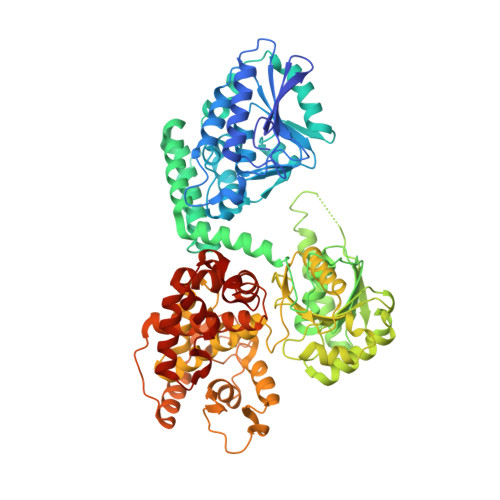Structural enzymology studies with the substrate 3S-hydroxybutanoyl-CoA: bifunctional MFE1 is a less efficient dehydrogenase than monofunctional HAD.
Sridhar, S., Kiema, T.R., Schmitz, W., Widersten, M., Wierenga, R.K.(2024) FEBS Open Bio 14: 655-674
- PubMed: 38458818
- DOI: https://doi.org/10.1002/2211-5463.13786
- Primary Citation of Related Structures:
6ZIB, 6ZIC - PubMed Abstract:
Multifunctional enzyme, type-1 (MFE1) catalyzes the second and third step of the β-oxidation cycle, being, respectively, the 2E-enoyl-CoA hydratase (ECH) reaction (N-terminal part, crotonase fold) and the NAD + -dependent, 3S-hydroxyacyl-CoA dehydrogenase (HAD) reaction (C-terminal part, HAD fold). Structural enzymological properties of rat MFE1 (RnMFE1) as well as of two of its variants, namely the E123A variant (a glutamate of the ECH active site is mutated into alanine) and the BCDE variant (without domain A of the ECH part), were studied, using as substrate 3S-hydroxybutanoyl-CoA. Protein crystallographic binding studies show the hydrogen bond interactions of 3S-hydroxybutanoyl-CoA as well as of its 3-keto, oxidized form, acetoacetyl-CoA, with the catalytic glutamates in the ECH active site. Pre-steady state binding experiments with NAD + and NADH show that the k on and k off rate constants of the HAD active site of monomeric RnMFE1 and the homologous human, dimeric 3S-hydroxyacyl-CoA dehydrogenase (HsHAD) for NAD + and NADH are very similar, being the same as those observed for the E123A and BCDE variants. However, steady state and pre-steady state kinetic data concerning the HAD-catalyzed dehydrogenation reaction of the substrate 3S-hydroxybutanoyl-CoA show that, respectively, the k cat and k chem rate constants for conversion into acetoacetyl-CoA by RnMFE1 (and its two variants) are about 10 fold lower as when catalyzed by HsHAD. The dynamical properties of dehydrogenases are known to be important for their catalytic efficiency, and it is discussed that the greater complexity of the RnMFE1 fold correlates with the observation that RnMFE1 is a slower dehydrogenase than HsHAD.
Organizational Affiliation:
Faculty of Biochemistry and Molecular Medicine, University of Oulu, Finland.

















